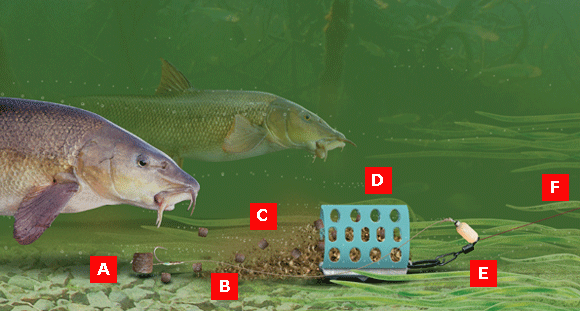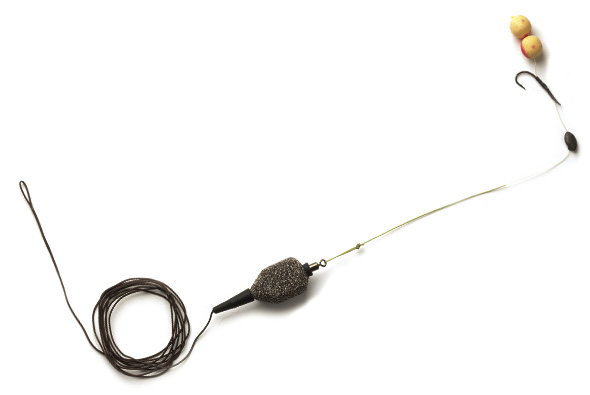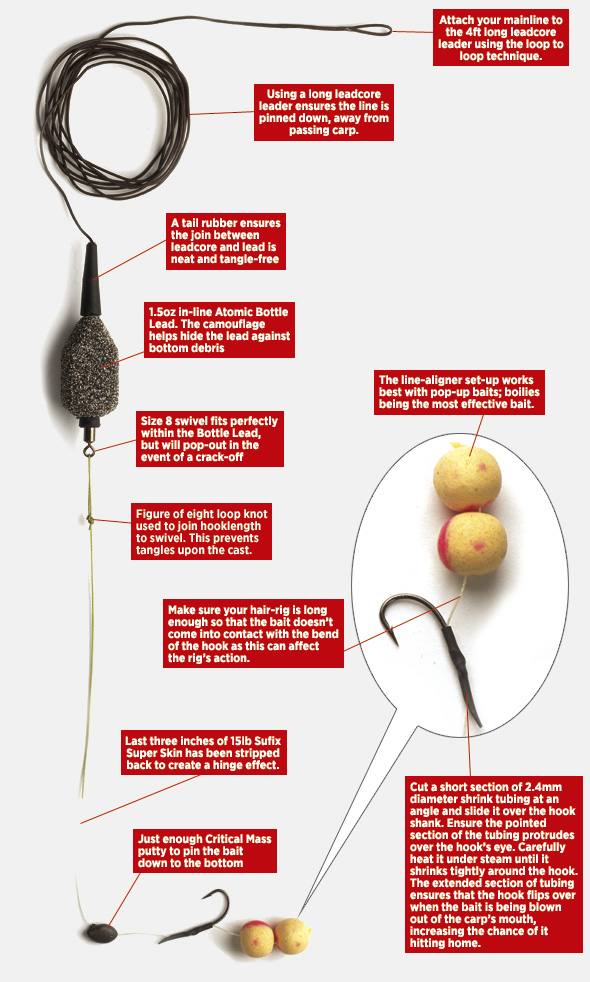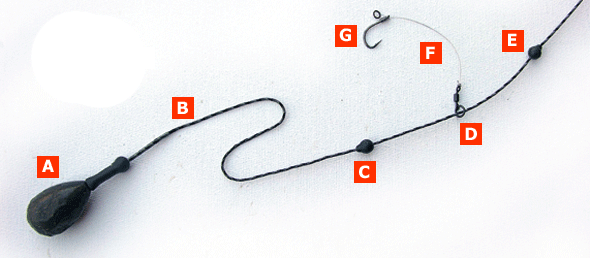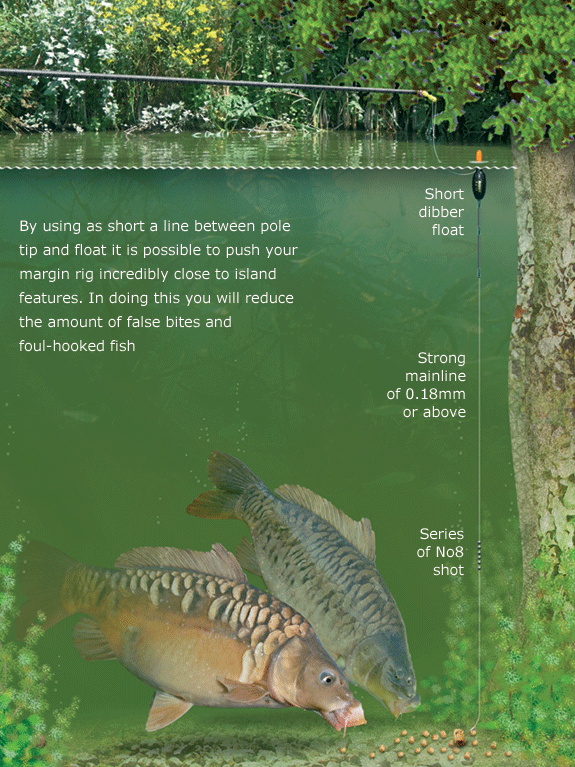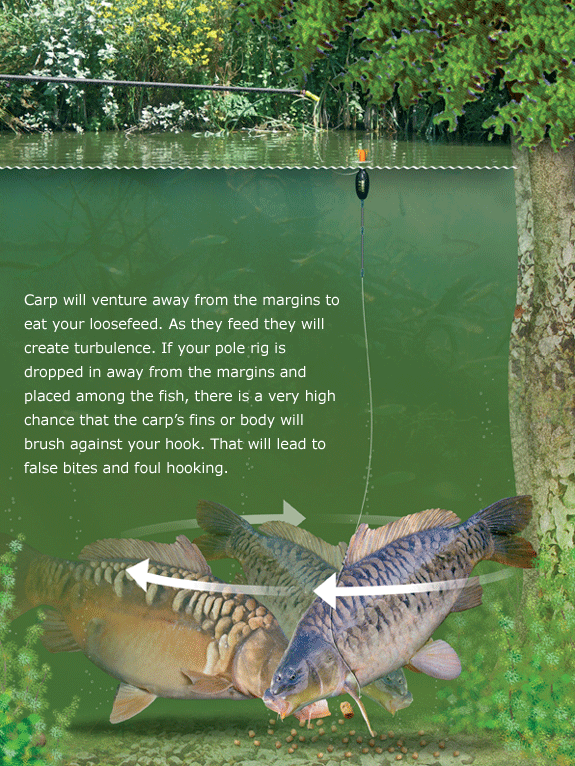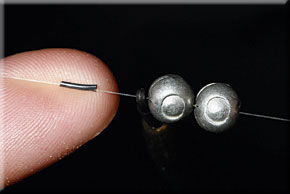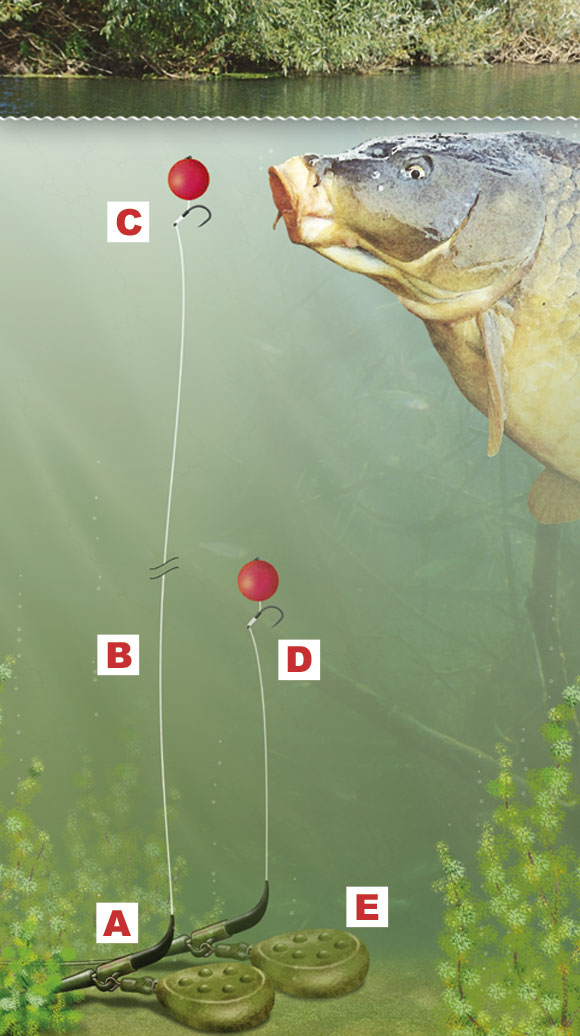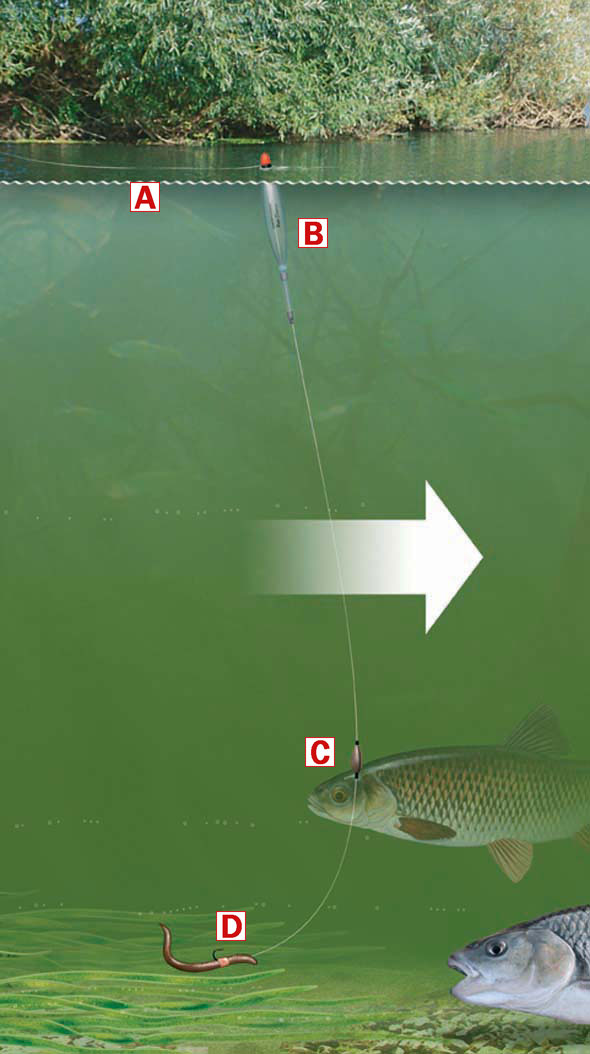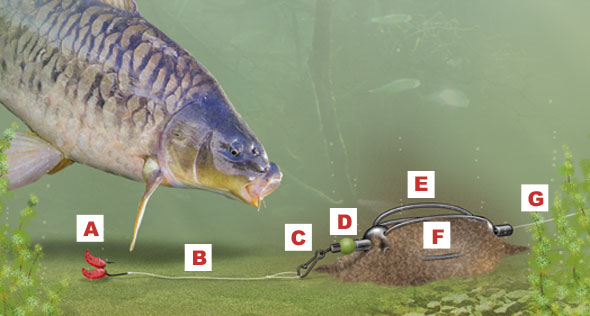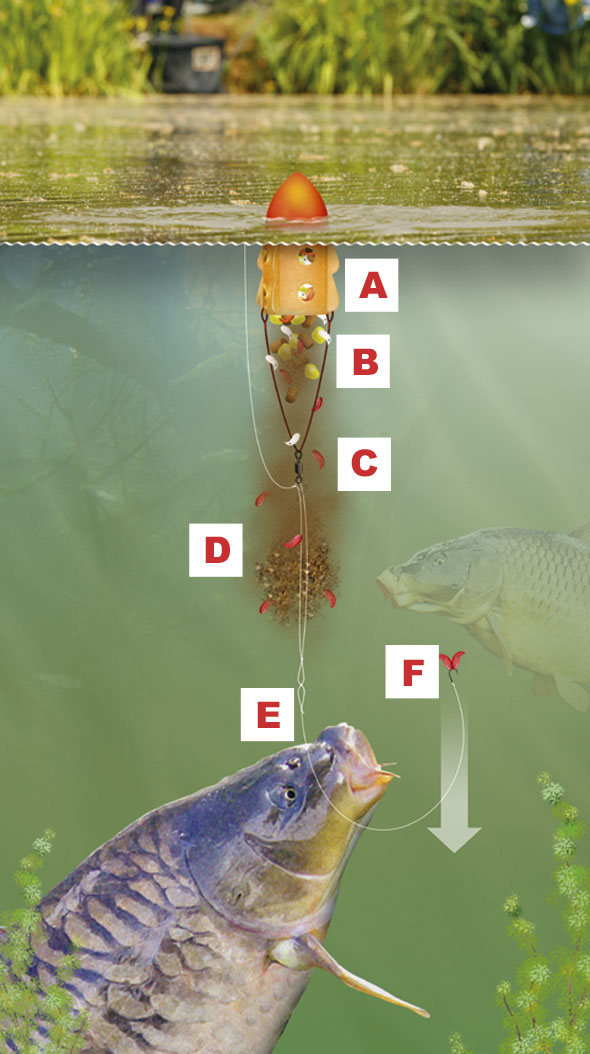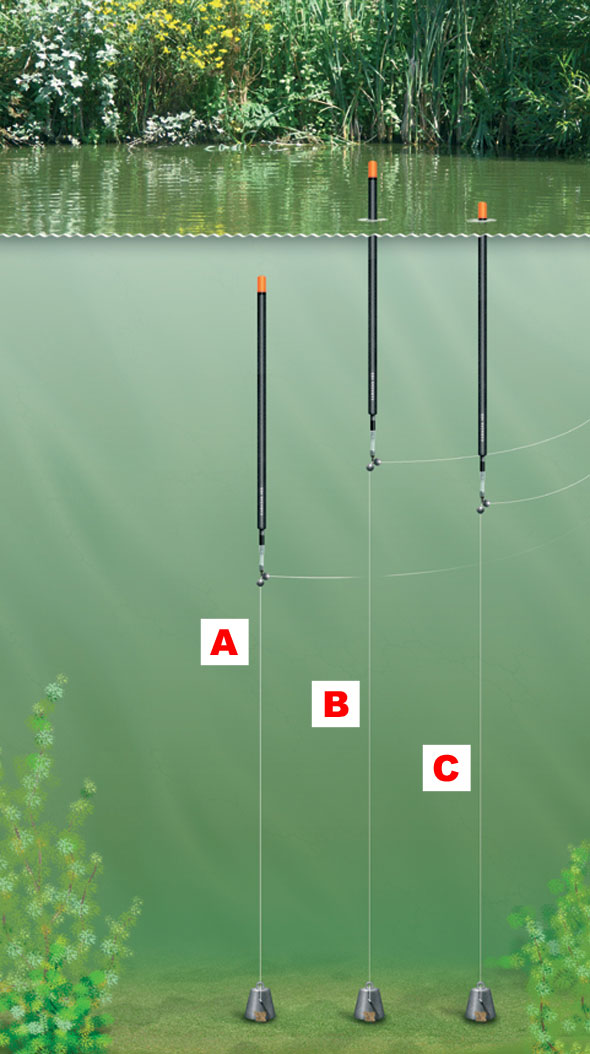How to tie a flatliner surface controller rig
When it comes to surface fishing, the best way to do it is to keep everything simple. Always feed the swim first, get the carp taking your baits confidently and only then introduce your hook bait. Surface feeding carp are cautious at the best of times; feed them in to a frenzy and you can almost cast right on top of them!
Always cast your rig past the feeding fish, then slowly draw the hook bait back in to the feeding zone. Carp are not the best at taking baits from the surface so you need to keep a keen eye on the line and not always the hook bait. It’s best to keep the line fairly tight to the controller, not allowing for any bow in the line, therefore you’ll be able to hit takes a lot easier. It also pays to use either a floating mainline or grease your line to ensure that the mainline floats; this will also help you to hit takes swiftly.
Another tip is to use a slightly different hook bait than your loosefeed. A little edge is to use a floating pellet when feeding Chum Mixers, attached to the back of the hook using a bait band.
The rig I use is semifixed. The two John Roberts’ rubber beads used to fix the hooklength are pierced through the side using a baiting needle. The mainline is then looped over the needle and pulled through the bead. This locks the swivel in place, but if a breakage occurs the carp will easily be able to pull the hooklength from the mainline.
Give surface fishing a go as it’s the most exhilarating way of carp fishing - the anticipation is intense!
Groundbait feeder rig for river barbel, chub and bream
This simple yet very effective feeder fishing rig is perfect for catching river barbel, chub and bream. It’s easy to make and can be used in deep sluggish rivers through to fairly shallow and swift flowing rivers.
The beauty of this rig is that it can be used to catch all of our larger river species, providing you use an appropriate bait and loosefeed to tempt them.
All you’ll need to tie this rig is a variety of different weight of feeders, some eyed hooks, some hooklength braid, strong mainline, a snap link swivel and a buffer bead.
Buffer beads are small rubberised sleeves that fit over half of a swivel. They can be found at all good specialist fishing tackle stores and are ideal for stopping your swivel from hitting knots and potentially weakening them.
The most important part – and often the most technical – is choosing the right weight of feeder. The feeder must be an open end type. Cage feeders simply release their load of groundbait too quickly, whereas open end feeders hold on to the groundbait until the feeder hits the river bed.
Getting the right weight of feeder requires a few experimental casts. Pick a feeder that you think might offer enough weight to hold still in the flow, cast it out and see if the feeder remains static on the bottom. Ideally you should choose a feeder that only just holds still in the flow – one that will easily dislodge and begin rolling if a fish were to pick up the bait and nudge the feeder out of position.
Two of the best baits for this rig are either large drilled halibut pellets or fishmeal boilies – bream, barbel and chub love them. But you could use maggots, worms, casters, sweetcorn, anything you wish.
The feed you put inside the feeder ought to match the hookbait you’re using. If you decide to use a halibut pellet or a fishmeal boilie on a hair rig, you will do best to use a fishmeal groundbait and pellets in your feeder.
HOW TO TIE THIS RIG
A – Larger baits like pellets and boilies should be hair-rigged. You’ll need a strong eyed hook for this and the best way to tie a hair rig is to use the knotless knot.
If you intend to use more conventional baits, just choose a strong hook of a size to suit your chosen bait.
B – It’s your choice whether you decide to use a mono or a braid hooklength. If you decide to use a mono hooklength pick one that will cope with a barbel, so 6-8lb breaking strain will be ideal. If you opt for braid, chose a 12lb breaking strain.
C – Your loosefeed should match your hookbait. Fishmeal groundbait and pellets is an ideal match for boilies and drilled halibut pellets. This combination scores well for river specimens.
D – Your open end feeder should have enough weight in the lead to just hold still in the river’s flow.
E – Use a quick-release snap link swivel to attach the feeder, and a buffer bead to attach your hooklength.
F – Your mainline needs to be strong enough to cope with a big barbel, so choose 8lb or 10lb breaking strain.
How to make the perfect feeder rig for fishing close to islands
Anyone who fishes commercial carp waters will know that islands are a prime area to target for good carp weights. Float fishing is almost impossible due to the amount of line hanging underneath the float - this can catch in overhanging vegetation, so the only effective way to fish tight to an island is to use a feeder rig set up.
Here we show you one of the very best feeder rigs to use when fishing tight to an island feature, in a handful of easy-to-follow steps to make sure you can easily create this rig.
It's worth bearing in mind the style of feeder used here - it's a cage feeder. These feeders are the best choice to use in shallow water around an island as the large holes in the sides allow water to enter rapidly, therefore the attractive groundbait inside escapes quickly to leave a cloud of scent in the water.
1. You will need a 1oz Korum cage feeder, size 16 Korum S3 hooks, size 24 mini swivel, 0.13mm (4lb 12oz) Reflo Powerline for hooklength, Korum Rig Stops, plus Korum Quickstops and Quickstop Needle
2. First, push your hooklength through a Quickstop and tie it on with a simple overhand knot
3. Push hooklength through the hook eye – from the back – and measure out the hair length
4. Tie a knotless knot. Korum S3 hooks don’t have a gap in the eye, so they are safe with this knot
5. On the other end of the hooklength, typically 24 inches long, tie on a size 24 mini swivel with a safe knot like a six-turn grinner. This hooklength attaches on to the reel line above the feeder, helicopter style
6. Slide a Rig Stop on to reel line, add hooklength swivel then anotherStop
7. The swivel can spin freely between the Rig Stops, which slide up and down the reel line. This set-upreduces tangles, yet will pull apart if your reel line breaks so you do not tether a hooked fish
8. Now attach your cage feeder to the reel line, again using a proven knot like a grinner or half-blood. Leave a small tag end on the knot as to account for any slippage
9. Now push the swivel and Rig Stops down the reel line until they are 15cm (6in) above the feeder. Your hook will now drop 45cm (18in) below the feeder when you cast
10. The finished rig is effective and safe so it can be used at any fishery that enforces a ‘no fixed rig’ policy for fish welfare
How to tie the perfect in-line big carp fishing rig
A simple tubular extension on a strong carp hook can make all the difference between a lost and landed fish. Richard Farnan explains how...
The line aligner was first published by Jim Gibbinson many years ago. The principle behind the set-up is to create an angle that in itself creates a very effective anti-eject rig.
By using a length of shrink tubing cut at an angle, you elongate the overall length of the hook’s shank. Leaving the ‘tail’ of the tubing makes the hook go into the carp’s mouth in a straight line as the fish sucks up the bait. Upon ejection the hook flexes and spins giving it more opportunities to take a hold.
This set-up is best used with popup boilies presented approximately two inches off the bottom, held in place with a small blob of putty upon the hooklength.
The loop knot at the swivel end ensures no tangling upon the cast. Personally I prefer to use an in-line lead with this set-up and by using a leadcore leader everything is pinned to the lake bed, thus not alerting the carp to any danger. This combination is very effective indeed!
How to tie a Chod rig for fishing silty venues
When fishing for carp over very silty lakes, it is essential to choose a set-up that ensures your rig will not get buried in the soft silt and ruin an otherwise good presentation. And the best rig for this is the Chod rig.
It was specifically designed for just this sort of fishing. The chod has proved to be very successful and has accounted for a lot of big fish recently. It should be used with very buoyant baits and will work superbly in silty areas.
It works upon the principle that the rig can be adjusted to position the bait anywhere along the leadcore leader, so no matter how far the lead sinks into the silt, the bait will be in a prime position to sit above the bottom debris.
This rig incorporates a spliced leadcore leader and fairly tight-fitting beads that allow the hooklink to be semi-fixed anywhere along the length of the leader. Shop-bought Chod rigs are available, for those who don't want to tie their own.
The rig has safety in mind, and the soft beads will easily pass over the spliced joining loop, allowing the hooklink to pull free of the leadcore should a breakage occur.
Here's how to tie your own Chod rig...
A Use a lightweight swivel lead - 1oz is perfect. Keep the lead as light as possible because when you are playing a fish the hooklink will slide down to the lead, so the lighter the lead, the less chance of the fish being bumped off. A short strip of silicone tubing helps neaten the lead swivel.
B This is a leadcore leader. It offers enough weight to sink to the bottom. A 3-4ft length is about right.
C If you want to fix your Chod rig you can place a bead here, between the lead and the hooklink swivel. They need to be semi-fixed - a rubber bead sitting on a short piece of silicone is perfect. It is a personal preference whether you use a stop between your ring swivel and the lead.
D Flexi ring swivel of either a size 11 or 12. It should offer just enough weight to anchor the pop-up. This type of swivel provides a full 360 degree movement, so if a carp sucks at the bait from any angle, the swivel will ensure that the bait can easily move and be sucked up.
E The top stop bead. When fishing in deep silt or weed this bead should be at least 2ft up the leader, but for cleaner bottoms it can be much closer to the lead.
F 2-4ins of very stiff mono hooklink line. ESP and Fox produce some of the best stiff links for the job. 15-20lb breaking strain is about right.
G The hook must have an out-turned eye with a D-Rig knotless knot whipping on the shank. This rig works well with a big hook, even if you are using a 14 or 16mm pop-up boilie. And the perfect bait for a Chod rig is a 14-16mm pop-up boilie that will not sink, regardless of how long the rig is submerged.
Prevent foul hooking carp when margin fishing
We've all done it at some time - foul hooked a carp in the fin or flank when pole fishing tight to the margins or an island. It's almost inevitable that the feeding carp will, at some time, swim into our lines and become foul-hooked.
Not only is this unsporting, but playing a foul-hooked carp is twice as hard as normal, putting your pole, elastic, hook and line under incredible pressure that often ends in disaster.
Although we cannot guarantee that this technique will prevent carp becoming foul-hooked, it will certainly decrease the chance of that happening. And in turn it will increase your confidence too.
Here's how it's done and how to tie it...
The key tackle requirements are a strong hook (eyed or spade end, it doesn't matter), strong mainline and a short dibber pole float. Then you'll need a handful of No8 shot to dot the float down to the bulbous sight tip.
When we say strong mainline, choose a high-tech line of around 0.18mm to 0.22mm diameter (between 6-10lb). That will be strong enough to cope with the rigors of this style of fishing.
All your shot should be placed together, in a line, below mid-depth.
You'll also need strong pole elastic. A grade 18 will be spot on, but you may get away with a 16 if the fish aren't enormous.
Finally, to fish this technique effectively you will need to use as short a line between pole tip and float. The reason for this is simple. You're going to have to push your rig as close to the margins or island as is possible. Having a short length of line above the float will help you do this effectively.
Plumb the depth carefully as your bait should just rest on the bottom an inch or two. Now you're ready to take the swim on, feed it and start catching.
The trick to the effectiveness of this rig is really very simple. If your rig is presented as close as possible to the margins it'll be positioned just out of the way of the feeding carp. Also, when a carp does pick up your bait and you strike, there's a very high likelihood that the carp will swim directly away from the margins and into open water, where you'll be able to gain control of it quickly. Obviously there's no way the carp can swim forwards, because of the island or the bank.
Take a look at the diagrams below and you'll see why it's important to fish as close as possible to the feature.
THE RIGHT WAY
THE WRONG WAY
How to rig and fish with a pellet waggler
The pellet waggler is one of the best ways to put together a huge haul of commercial carp during the warmer months. It's basically a floatfishing tactic that relies on heavy feeding to bring carp into your swim and feeding just under the surface where they compete for the loosefeed.
The best bait for this style of fishing is and will always be sinking pellets of between 4mm and 10mm, depending upon the distance that they need feeding.
And although the rig - detailed below - is very very simple to create, it's the feeding that will make or break a session fishing the pellet waggler.
The key is to feed little and often, any by this we mean feed around 6-10 pellets every minute. This will create lots of tapping noises on the surface which will help attract the carp, but it will also create a constant stream of bait falling through the water.
Once the carp find this falling bait they will start to intercept it and eventually rswim up higher in the water to get at the pellets before all the other carp. Evenutally they will rise so high in the water that you will see swirls on the surface as soon as a new batch of pellets hits the surface.
And that's the time to cast out you float and let your pellet hookbait fall right on the nose of the carp underneath!
1. 3-5SSG Silverbacks from KC Angling are ideal. Others are by Drennan, Middy, Maver Preston, Ultra and Premier
2. You have to use large SSG shot but thread lengths of GURU 0.3mm micro silicone tubing on the line and pinch shot on to this
3. The silicone acts as a buffer and stops the shot pinching directly on the mainline. This cushions the line and prevents damage
4. Leave half-inch gap between shot. This makes the float lay on the surface when it lands, making a larger splash. It flattens on the strike to improve hook-up rate
5. In open water situations where there are few snags Alex uses 4lb GURU Drag-Line on his reel and 0.20mm Shimano Silk Shock Antares as his hooklink
6. Now for the hooklink. Cut off around 15 inches of Antares 0.20mm diameter line and thread it through a GURU rubber bait band
7. Tie a four-turn grinner knot to attach the band to the end of the hooklink. Snip off the tag end of line.
8. This knot allows the band to hang straight down from the hooklink line, producing a good angle with the hook when it is attached
9. Thread micro silicone tubing on to the hooklink. This will help position bait against the hook at the correct angle for hooking fish
10. Thread the top end of hooklink through the back of the hook eye. Slide line through it to pull the bait band up to the bend of the hook
11. Thread the silicone over the hook point and slide it round the bend on to the shank
12. The silicone sleeve holds the line tight to the shank of the hook, keeping the bait band close to the hook point
13. Thread hooklink through the back of the hook eye and whip it down the shank. Whip away from where the hook eye is closed against the shank
14. Whip the line down the shank, making 10-11 turns of line, then thread the hooklink through the back of the hook eye again
15. Moisten coils and pull line tight. This is the knotless knot. Tie Figure of 8 loop in the hooklink and attach to mainline using a loop-to-loop connection
16. Get a hard 8mm Bait-Tech feed pellet and pinch it against the bottom of the bait band
17. Still pinching the band against the bait stretch it beyond the pellet and pull it over it. The bait is now circled by the band.
18. The band grips the bait firmly and stops it flying off the rig on the cast. You should be able to make several casts with the same bait
19. The final rig is best used in water at least five feet deep with the float set to fish the top couple of feet. Shorten or increase depth on the day.
How to make a reverse hair-rig for carp fishing
Rig presentation is everything to big-carp specialist Richard Farnham. He's always looking for a better way to present his bait, especially when tackling waters such as the renown Horton Church lake - where takes are very few and far between.
Many years ago, during a full season tackling the venue where blanks are common, he set to work creating a new rig that might well transform those tentative pick-ups that carp can give into full-blown runs.
The idea was to create a rig where the carp found it absolutely impossible to suck up the bait and eject it without the hook point connecting with the fish - and so his reversed hair-rig was formed.
This rig transformed a terrible season on the venue. After a little tinkering with the set-up, and adding tungsten putty to pin the braided hooklength down, and flying backleads to sink the mainline to the bottom, Richard began to get runs.
His newly developed reversed hair-rig produced a new personal best carp for Richard - Shoulders at 42lb 8oz. This proves without a shadow of a doubt that this rig can effectively be used to effectively fish for very shy and wily carp.
Cut off a length of braided line and tie a small overhand loop in the end. Thread the braid through the back of the hook’s eye
Fold the braided hooklength over like this. Remember to make the distance between the loop and the hook’s eye long enough to fit your bait.
Whip the tag end of braid around the folded-over braid and the hook shank enough times to cover the doubled-over braid
Make another whip upwards, over the other whippings and pass the tag end through the back of the eye once more. The knot is now complete.
How to make an anti-eject rig for big carp
Knowing how to tie and create an anti-eject rig can and will put you streets ahead in terms of putting more carp on your unhooking mat simply because this type of rig is really difficult for the carp to blow out their mouths, therefore there's a mugh hgher chance of the hook point hitting home.
In general, stiffened lines are not usually used as a hooklength for bottom bait presentations, but by adding a short and supple braided section between the hook and stiff hooklength gives the rig remarkable anti-eject qualities.
A great hook for this is a Mugga. This hook pattern has great turning properties in itself when a carp tries to blow the hook back out of its mouth, but add to this a sliding rig ring to create a ‘spit-back’ rig and the carp really do find this rig very difficult to eject. Another anti-eject aspect of this rig happens to be the ultra-stiff boom used to create most of the hooklength and the hinge created by the braid. The supple braid collapses in the carp’s mouth when the fish tries to eject the bait, the bait slides down the hook shank, the hook turns but the stiff boom prevents it coming all the way out. One nailed carp!
The stiff boom that is used is made and sold by Heathrow Bait Services. It’s 6 inches long and features swivels at either end. The business end - where the soft braided hinge is attached - features a very small swivel so as not to adversely affect the rig by weighting it down.
The lead is attached ‘on the side’ using a fi sh-safe Korda Lead Clip and Tail Rubber. If the lead were to become snagged the lead clip will come apart to release the lead and allow the angler to play the fish in safety.
This is a great rig to use in winter with small PVA bags of crushed boilies, and on the hair try using either two cut down (odd-shaped) boilies or a single bottom boilie. This is a cracking rig to try when bites are hard to come by.
Pinned down helicopter rig for snag fishing
Snag fishing knowledge and understanding how to fish really close to weed, reeds and underwater features is a great skill to have as it can help you put many more big, heavy, specimen carp on the unhooking mat.
We all know that snags are like a magnet to big carp - they use them as cover, plus the carp feed on waterlife that lives or drifts into the snag or feature.
Here you'll find how to create the perfect rig for snag fishing, and how best to use it...
Remember these rules when creating a rig for snag fishing: Use a flying back lead and rig tubing with putty or wire to keep the line above the rig pinned down to the lake bed. A pear lead can be used on a flat bottom, but try a Grippa for slopes. Finally, to allow easy release of the lead, push the tail rubber only one-third of the way on to the safety clip.
How to fish and create a slider float rig
You may well have read or heard about match anglers fishing a slider float rig. If you’ve ever wondered what they are talking about, read on as here’s a compact guide to tying a slider float rig and how to fish the slider…
A slider rig is one of the best ways to float fish a bait on the bottom in deep venues – those 10ft deep or more – because the float isn’t locked in position on the line like normal waggler rigs.
This means that any depth of water can be tackled, and casting is easy. Even when your rod is only 12ft, but the water’s way deeper than that.
Slider float rigs work on this principle: The large waggler float is attached to the line using a swivel float adaptor that allows the float to slide along the mainline. Below the float is all the shot required to cock the float. And above the float is a stop knot that prevents the float from going too far up the line.
There’s a certain way to set up the shotting below the float – just take a look at the diagram below to see how’s it’s done.
The position of the stop knot above the float will depend upon the depth. Basically, it’s a case of attaching a plummet to the hook, sliding the stop knot along the line to guess the depth and casting the rig to see if you’ve found the correct depth. Obviously the float will sink if the rig is set too shallow. Basically, that single stop knot positioned above the float takes the place of the split shot that you’d normally use around the float’s base.
The float must be of a certain style. Normal straight, crystal and insert wagglers aren’t ideal for this technique. The perfect float needs to have a large shot carrying capacity – something in the region of 4AAA and above is needed. And here’s why…
When this rig hits the water you must leave the bale arm open. The large waggler will rest on the surface for a second or two while the huge amount of shot drops, dragging line through the eye of the float adaptor. That’s why the bale arm needs to be open – so line can zip through easily.
Before you’ve time to blink the stop knot will hit the float adaptor’s swivel and suddenly the float will stand up and sink to the correct level, ready to detect a bite. That’s the time to snap over the reel’s bale arm and maybe take up any slack in the line, ready to hit a bite.
It’s a very ingenious method of float fishing and, as with most good things, it’s really very simple when it’s clearly described.
And what’s more, despite needing a gigantic float, this technique is very sensitive, so you’ll be able to detect the most gentle of bites – often spotting more bites than you would if you were feeder fishing the same swim.
SLIDER FISHING TRICKS
You must use a swivel float adaptor when fishing the slider to ensure your line passes through the float easily and quickly.
It’s best to use either a small piece of your mainline or slightly thicker fishing line for the stop knot.
If your stop knot slips, simply tie a second one onto the line and push them together. Obviously they both must be tied onto the line above the float.
Leave around 1in of line protruding from each side of the stop knot as this will help prevent the float slipping over the knot.
Don’t use a waggler rod with really tiny line guides, especially of you have to cast long distances, as this will cause too much resistance and you may not cast the distance required.
If all your swivel float adaptors have large swivels, simply crush the swivel loop into an oval using pliers. That works for Alan Scotthorne, so it’ll work for you too!
How to tie a helicopter-style Method feeder rig
The method feeder is a deadly technique for catching carp and bream. The groundbait that is moulded around the frame attracts the fish, they nudge the crumbs to try to get to any larger food particles inside and then they find your hook bait - that's when the fish hook themselves against the weight of the feeder and its lead.
There are two different ways to create a method feeder rig. One is to fish it in-line style so that the mainline runs through the feeder and the hooklengths attaches to that. This technique is a good one, but it's not the best. This sort of rig can tangle, so another alternative is the helicopter-style method feeder rig detailed below.
This method feeder rig is widely used by specialist carp and bream anglers, it can be cast very long distances, it's easy to create, it's near fool-proof and it's almost 100 percent tangle-free.
Here's how it's tied...
To set the feeder up helicopter-style, Joe uses a Korda Safe Zone leader
Thread the mainline through the feeder, through the eye of the leader and back through the feeder. Pull the mono to thread the feeder onto the leader.
Slide the feeder down the leader and push the base on to the swivel at the end of the Safe Zone leader
Similar to the in-line rig shown above, this semi-fixes the feeder onto the leader.
Using a baiting needle, thread on a 6mm bead, followed by a size 8 Korda ring swivel with hooklink attached and then a second 6mm bead
Hook the eye of the leader on to the baiting needle and gently slide the beads and ring swivel on to the Safe Zone leader.
Push the beads and swivel down the leader and position them just above the feeder to form the helicopter link.
Tie the end of the mainline onto the loop at the top of the leader and you are ready to fish.
Once again, the 6mm bead and swivel will easily pull off the leader if the mainline snaps.
How to set up an in-line bolt maggot feeder rig
In-line maggot feeders are relatively new to the market but they have already helped catch many big carp, bream and tench to those anglers who know how to rig and set them up correctly.
Here Bob Roberts shows us how he sets his up when fishing specialist-style for big tench...
This technique not only ensures that the fish hooks itself against the weight of the heavy maggot feeder, but it also ensures that the fish are brought straight to the hookbait due to the accurate placement of the wriggling maggots escaping from the large in-line maggot feeder.
It's a really simple rig to tie and one that you could use the next time you're seeking a big carp, tench or bream.
This method will work on rivers for barbel and chub, providing you use a feeder that has enough weight to hold the bottom in the strong current, but ideally it's more of a stillwater technique used alongside bite alarms and indicators...
How to do it...
1. Get a Drennan Bolt Blockend feeder, size 16 Drennan Carp Method hooks, size 9 E-S-P Uni-Link swivel, 10lb Drennan brai
2. Thread the feeder’s tail rubber down the reel line, followed by the feeder. The metal plate ensures it lands base down
3. The reel line runs straight through the centre of the feeder helping the rig become aerodynamic for castin
4. Cut a length of braid and tie to the hook with a grinner knot. Cut the link so it’s a little shorter than the swimfeeder
5. Tie the swivel on the hooklink with a Palmor knot and lock it in the feeder. The hooklink is shorter than the feeder
6. Lift the cap off the feeder – the stem is flexible to make this easier. Load a handful of maggots inside the feeder
7. Fill the feeder but don’t pack it too tight. Leave a gap so the maggots can wriggle better and exit the feeder quicker
8. When a fish picks up the hookbait on such a short link, the line is pulled tight to the heavy feeder and the hook sinks home
How to tie a Zig rig to catch carp mid-water
The zig-rig is a devastating rig for catching carp when they are feeding high in the water, in mid-water and feeding right on the surface.
It works around the same principle as a standard semi-fixed bolt rig – the only difference is the length of the hooklength.
The lead set-up is very simple. Here it comprises a large swivel lead attached to the line using a safety clip. A swivel joins the mainline to the hooklength, but here it’s covered in a short length of tubing to prevent tangles.
The hooklength must be a clear line (fluorocarbon is best) so as not to spook the fish, and the length of it must be shallower than the depth of water.
To find the water depth you may need to use a marker float set up, then from this you will be able to find the depth and then create a hooklength long enough to present the bait at the required depth – sometimes just 6in under the surface works best – sometimes mid-depth will get you more bites.
Bite registration ought to be the same set-up as you normally use – an alarm and an indicator.
A Remember to use a length of tubing over the swivel as this will prevent tangles.
B Fluorocarbon line is best for this rig, but clear mono will also catch you fish.
C Use a large pop-up boilies as this will provide the buoyancy to suspend the bait well off the bottom.
D In mild water conditions, a bait presented at mid-water will gain you more takes.
E Use a gripper-style lead to hold the bottom securely as you will never know if you have cast your rig onto a steeply-shelving bottom.
How to use a chubber float for fishing shallow and fast rivers or streams
The short, fat and dumpy chubber float is perfect for fishing shallow and fast river glides or trotting on streams. It’s capable of carrying a lot of shot, due to the size and buoyancy of the float. This is perfect because fast, shallow swims need a lot of lead down the line to ensure that the bait is pushed down to the bottom right where the fish are.
A typical chubber rig is simple to tie, and here’s how…
A Your mainline ought to be a floating one. Drennan Floatfish is perfect. Choose a breaking strain that matches the fish that you are likely to catch. A 3lb line will be adequate for most situations, but you may need to step up to 5 or even 6lb if there are lots of big barbel present.
B The chubber float needs to be attached to the mainline using three rubbers – one just under the sight tip, one in the middle and one at the base of the float.
C There are two ways to shot a chubber float – either use a string of large shot (BBs, AAs or even SSGs) placed around 1ft from the hook, or alternatively use an olivette. This creates a much smaller and neater bulk of weight.
D Because chubbers should be fished in fast water, the fish don’t have that much time to check out the hooklength, so this sort of rig can be fished straight through to your hook. You still need to match the hook size to the size of the bait you are using.
How to find underwater features using a marker float rig
This simple yet amazingly effective marker float rig diagram will enable you to ‘see’ all those hidden underwater features and therefore ensure you can place your bait right where you need it.
This rig can be cast to various spots around the lake to not only find the depth in that particular spot, but also to find out what lies on the bottom – weed, gravel, mud or silt.
With a little experience you can very quickly figure out the exact make-up of the bottom of the lake you are fishing and determine which areas are likely to hold the fish and therefore where you think you will be best casting your bait.
All you need to create this set up is a spare carp rod (preferably around 2.75lb test curve), a reel loaded with strong braid, a marker float, a heavy swivel lead (of around 2oz or more), a length of strong monofilament, a strong baiting needle, a cork ball and a run ring with bead.
The reason for using a strong rod and strong braid is so the angler can ‘feel’ the bottom of the lake. Basically the combination of strong stiff rod and braid helps transmit every knock and bump of the lead along the bottom to the angler’s hands. It’s hard to describe in words, but with a little practices you’ll be able to tell exactly what lies on the bottom by the feeling you get through the rod and braid when the leads moves.
Building the link for the rig
Creating this rig is really very simple… Cut off 14in of your strong monofilament and tie one end to your swivel lead. Now pierce the cork ball with your baiting needle and draw the strong monofilament through it so the ball is trapped upon the line. Now tie the run ring to the end of the strong line.
To complete this link, push the cork ball onto the base of the run ring. You could glue this in place if you wish.
Setting up the rig
Thread your braid through the guides of your spare 2.75lb test curve carp rod and pass it through the run ring of the link you made earlier. Now thread the braid through the run ring’s bead and then tie it onto the base swivel of the marker float. Job done!
Using the rig
You must cast this rig with a fluid motion – not a jerky cast – so you don’t tangle it. And once the rig lands gently wind the reel’s handle to send the large marker float down to the bottom where it will contact the link and lock up.
You’ll feel this through the rod, when the float hits the link and the line tightens fully.
Now open the reel’s bale arm and pay out line 1ft at a time, remembering to count as you go and remember to add the 12in (1ft) that forms the link. Keep paying out line and counting until you see the float break the surface. Whatever figure you arrive at – that’s the depth.
Remember that figure, or better still write it down, and then gently wind the float back down again until it locks up against the link.
Now gently pull the rod around to your side, while keeping the reel locked up, and drag the lead along the bottom.
You’ll feel various things through the rod depending upon the substance that the lead travels over.
If the lead hits into weed, the rod might well lock up solid and then jerk round again as you pull on the lead.
If the lead passes over flat mud or through silt you’ll feel a constant but smooth pressure.
If the rod passes over gravel or rock you’ll feel a definite tap-tap-tap feeling through the rod.
Once you’ve pulled the rod right round to your side, swing it around again to point directly at the lead, wind down again slowly and pay out line until the float pops to the surface, counting the depth as you go.
Do this many times in a wide variety of places around the lake and you’ll begin to build up an excellent picture of the bottom of the lake with all its little dips, troughs, gravel bars, weed beds and ledges.
Get the right distance
If you find a real corker of a feature there's only one way to ensure that you hit that spot. Cast to it with your marker float and once you've found it again, clip the line around your line clip.
Wind the rig in and place both your marker float rod and your fishing rod onto rod rests and open the bale arm. Now walk the marker float and the fishing rig out until the line hits the clip. Once you've done that, place the rigs onto the ground, walk back to the rods and clip up the line of your fishign rod.
Now you'll always cast the right distance and hit that spot every single time you cast!
If you are new to this rig and aren’t exactly sure what you ought to be feeling through the rod when you pull your lead across mud, gravel, silt or into weed then try this trick… Simply visit a lake that has all those features in the margins, drop your lead onto those features, walk the rod away from them and simply drag the lead across or into the features and note what it feels like through the rod.
Resistance-free running rig for big perch
This is THE rig to use if you are targeting specimen perch. Although it’s quite simple to tie, the components you will need are quite specialised but can be bought from all good tackle shops.
A Run Ring is a must because this provides a large diameter bore through which the line passes, therefore resistance is kept to a minimum. Big perch will drop a legered bait if they feel the slightest resistance.
The Run Ring will need covering with some silicone tubing to prevent tangles, and then a snap link swivel can be clipped to the Run Ring so that any weight of lead can be used quickly and easily.
The best hooklength lines should be soft, supple and camouflaged – either a braid or clear mono is ideal. Length needs to be between 2ft and 4ft.
One of the best baits for big perch is a couple of lobworms, so this means that the hook will need to be quite large. A size 4 wide gape will be ideal, preferably barbed so that the worms remain on the hook.
A Use a Run Ring followed by a bead and a swivel. The Run Ring reduces the amount of resistance to the taking fish.
B The size and weight of lead ought to suit the distance that you intend casting. You could switch the lead for a feeder crammed with red maggots or chopped worms if you wish.
C It’s best to incorporate a snap link swivel into this rig so you can change the lead quickly at any stage during the session.
D Use a large swivel and a very strong knot to lock on your hooklength as there’s every chance you may encounter a large tench, carp or bream fishing with this rig.
E Hooklengths need to be strong and short – 2ft to 4ft is ideal and between 4lb and 8lb is best.
F When fishing with two lobworms hook them in the saddle with a wide gape size 4 hook.
G Chop and change your baits between using whole lobworms and broken lobworms to find out which bait the fish respond to best.
In-line Method feeder rig for carp, bream and tench
The Method feeder is a devastating item of tackle for the commercial carp angler as it not only attracts fish to the swim, but it’s easy to use and easy to catch fish with!
To create this rig you’ll need to thread an in-line Method feeder upon your strong mainline – between 8lb and 12lb is ideal. Next thread a small bead onto your mainline and tie on a strong swivel.
The hooklength you will need should be very short and very robust, again between 8lb and 12lb breaking strain line is ideal. And an ideal length would be between 3in and 6in, because the bait needs to be presented as close as possible to the feeder.
Ideal baits for fishing the Method ought to be the best baits being used on the venue at the time, so ask the venue owner or regulars before you arrive to give you an idea of what to use for the best results.
Groundbait to mould around the feeder is quite important as not all groundbaits work. Ideally choose a specific Method Mix as these groundbaits bind together well and will therefore stick to the frame of the feeder.
You’ll need to mix the groundbait with a little water then take a small handful and press it into the frame of the feeder. Then, using both hands, squeeze a little more groundbait around the frame so that it is completely hidden by the mix. Don’t overfill the feeder as you’ll struggle to cast it out.
The best rods for this style of fishing are either power feeder rods or 2.5lb test curve carp rods.
The key to a good Method Feeder session – as with all forms of feeder fishing – is to consistently hit the same spot to build up a bed of bait that the carp will be drawn to.
A Use the best baits on the venue at the time you’re fishing. Ring first and you’ll get the right info!
B Use a very short and strong hooklength as bites can be savage when fishing the Method. A 3-6in length of 8-12lb line or braid will be perfect.
C A snap link swivel will allow you to tie two or three hooklength and bait them up when you are waiting for a take. Then, after landing a fish you’ll be able to release the old hooklength and clip on a new one quickly and easily.
D Remember to use a bead to absorb the shock of the feeder on the swivel knot during casting.
E In-Line Method Feeders are best because if your line snaps the fish can pull the rig free from the heavy weight.
F Remember to use a specific Method Mix for your groundbait as it will bind to the feeder correctly and stick to it during the cast.
G Your mainline will need to be tough enough to stand up to the pressure of fishing this technique – 8lb to 12lb mainline is best.
How to tie the rocket feeder rig for carp near the surface
The Rocket Feeder only entered the fishing world a couple of seasons ago and it certainly made an impact. It works around the same principle as a spod whereby loosefeed is cast out within a rocket-shaped device to feed a swim accurately at range, but here there’s a baited hook attached.
The Rocket Feeder itself is a small conical plastic device that is a cross between a feeder and a large float. It has fins for stability during casting, holes to let the feed escape and a bright orange sight tip containing foam for added buoyancy.
Under the feeder there is a link and a swivel to join it to the mainline.
The principle behind this is to be able to fill the Rocket Feeder quickly and cast it out to create a cloud of slow-sinking loosefeed that the carp will intercept to take on the drop. Then your bait is presented on a fairly short, unweighted hooklength to catch the fish high in the water.
In order to ensure that the bait remains inside the Rocket Feeder on the cast, a small layer of soft groundbait can be used as a plug – this also helps cloud the water upon impact too, helping to draw even more carp into your swim.
A The Rocket Feeder is a highly buoyant cross between a float and a feeder.
B Fill the feeder with small slow-sinking baits like casters, maggots and pellets.
C It’s best to attact your Rocket Feeder onto the line using a long loop.
D The groundbait plug will create a highly-scented cloud in the water that attracts even more fish to your swim.
E Make sure your link between mainline and hooklength is a strong one as bites can be really savage.
F Use small baits on the hook to ensure that they sink slowly, therefore giving the carp plenty of time to see and take them as they fall.
How to plumb the depth when floatfishing a waggler
Close in
Hold the plummet in one hand and your rod in the other – flex the tip of the rod slightly by pulling the line taught. Open the bail arm of the reel. Swing the rod upwards, let go of the plummet and take your finger off the spool to cast the plummet into the swim. Timing and a smooth motion is crucial, so do it very slowly to begin with to gain practice. Casting the plummet in this fashion minimises the disturbance it causes when it hits the water – but you can cast it overhead just like you would a float if you can’t master this way.
At distance
Pinch an SSG weight onto your hook (inset). Cast it into the swim in an overhead fashion. As long as the SSG is enough to sink your float it will take it out of sight if you are too shallow. When you can only see the fluorescent part of the float, it is set at a dead depth.
A. This shows you are too shallow.
B. This shows you are slightly too deep.
C. This shows you are just on the bottom.


